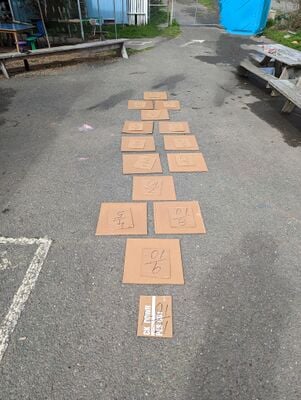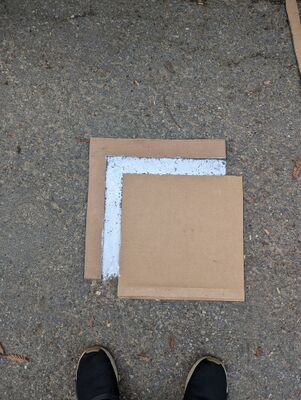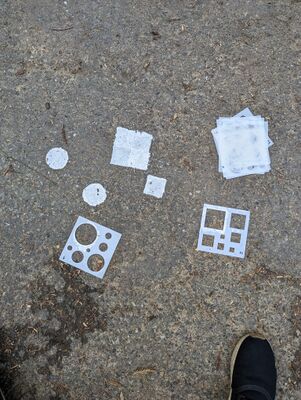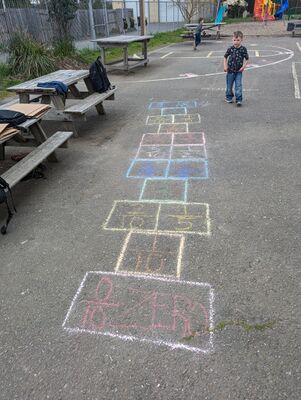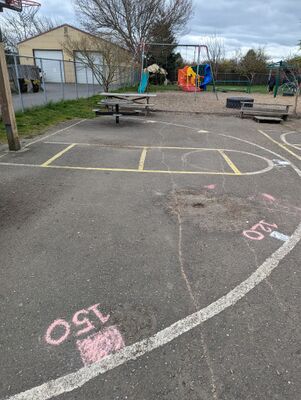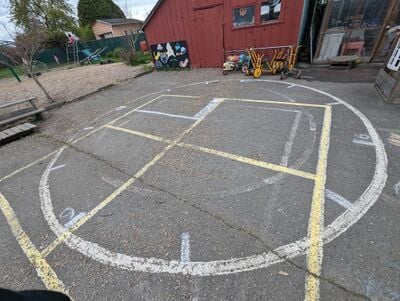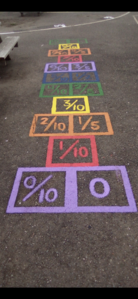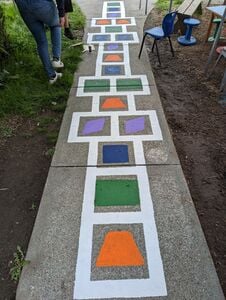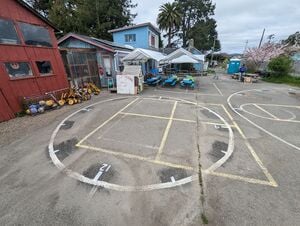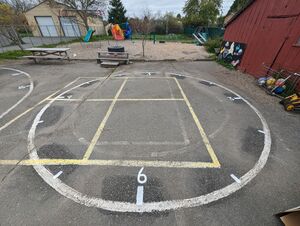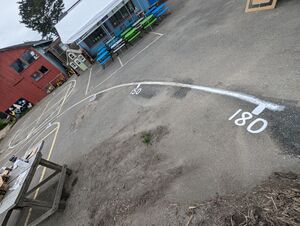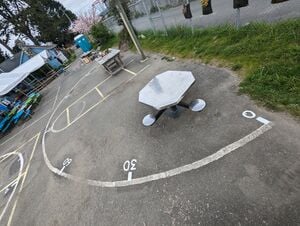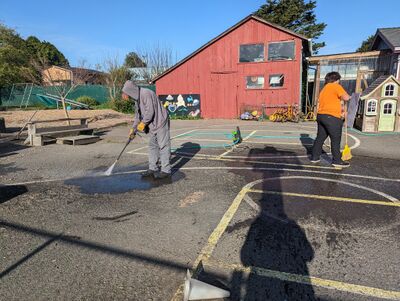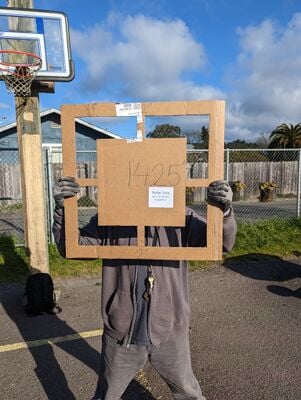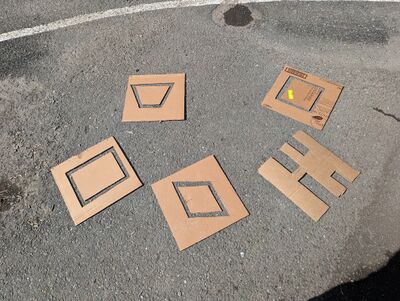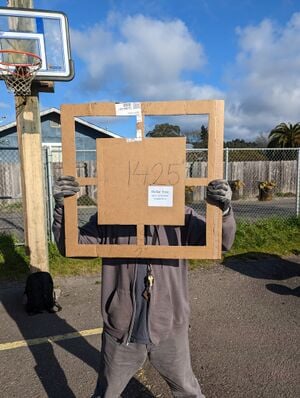
Math paths are painted math themed pathways for elementary school students. This design consisted of four main parts, those being a fraction hopscotch, a shape hopscotch, a marked protractor three point basketball line and clock tick marks with the four main hours on display. These paths are being used by the students of Trillium Charter school in Arcata, California. The paths all contain parts of the students' math curriculum and have given color and freshness to the blacktop playground area allowing for these math concepts to be more present in the students' surroundings.
Background[edit | edit source]
The Trillium Charter School (TRC) is a transitional kindergarten through 5th grade (TK-5) public elementary school in Arcata, CA. Mrs. Katie Dens is a teacher at TRC and is Team Trillium Math path’s project sponsor. It is Mrs. Dens’ desire for her students to not only get exercise during recess but implement mathematical learning at the same time. At the school is a large black top and an original hopscotch pattern on the sidewalk. The blacktop and hopscotch is an outdated, dull design for keeping the attention of elementary-aged school children. Mrs. Dens feels that an updated version of blacktop and hopscotch would serve the purpose of providing her students with exercise and learning at the same time.
The students working on this project are Ken Bray-Ali, Sebastian Hunter, & Austin Warchol. We are students in Lonny Grafman's Engineering 215 course during the spring semester of 2023.
Problem statement[edit | edit source]
The objective of this project is to design math themed paths for the kids of Trillium Charter School that they will enjoy and interact with while also incorporating parts of their math curriculum.
Criteria[edit | edit source]
The six criteria being evaluated are: Interesting, Simplicity, Safety, Durability, Aesthetics, & Cost. They are numbered in the table below by the weight we assigned to them as a group. The Interest of the project was the most important in the project because the ability to keep the children happy was the most important. Next would be the Simplicity of the project; the ability of the project to be understood by the students is an important fact in the project. Safety is a criterion that we decided was important because if our project hurt someone that would be a problem. The Durability of the project was decided to be the 4th highest requirement as we felt that the need to have maintenance is a trouble we did not think the school wants. The length of period it had to stand up to was decided to be 3 years. The Aesthetics was the next criteria with the constraint being the need to be appealing to the children of Trillium Charter. The last criterion is the Cost, it needed to be kept under a total of $700.
| Criteria | Description | Weight (1-10) |
|---|---|---|
| Interesting | Ability to keep attention of students | 10 |
| Simplicity | Needs to be comprehensible to students | 10 |
| Safety | Needs to not be a danger to students | 10 |
| Durability | Needs to stand up to daily foot traffic for 3 years | 8 |
| Aesthetics | Needs to appealing to the Trillium students | 6 |
| Cost | Under Budget of $700 | 2 |
Prototyping[edit | edit source]
The prototyping for the selected Math path patterns and corresponding paints was designed through two steps: Desired Prototypes, and Functionality Prototypes. In the first step, the desired patterns for the prototypes were selected from the solutions that were researched and created during the alternative solutions’ process and then sketched out with chalk in the desired locations. In the second step, the paint chosen for prototyping was tested for durability by first pressure washing a piece of asphalt and then applying the paint to the pressure washer surface as well as applying paint to the surface of a non pressure washed piece of asphalt. Each painted surface was allowed to dry for three days and then tested for durability using a wire brush.
-
Cardboard prototype of fraction path, testing for size
-
Prototype of stencil for the squares for shape and fraction path.
-
Small shape stencils
We did chalk prototypes to get a feel for the sizing and what our designs would look like once created on site. This was very useful to finalize our decisions for sizing, as well as, finding out which parts in particular were going to be the most challenging to paint in a professional manner.
- Chalk Prototypes
-
Chalk prototype of fraction path.
-
Chalk prototype of three point protractor.
-
Chalk prototype of clock tick marks.
Final product[edit | edit source]
Our final product was four different designs spread throughout the blacktop area. They are the colorful fraction path with fraction values inside the square, the shape path, which is outlined in white with colorful shapes centered in the squares, the clock with tick marks for the hours three, six, nine and twelve, and finally, the three point protractor basket ball line with tick marks every thirty degrees from zero to one hundred eighty. Totaling four different designs.
-
Finished fraction path.
-
Finished shape path
-
Top of finished clock
-
Bottom of finished clock
-
Right side of finished protractor design
-
Left side of finished protractor design
Construction[edit | edit source]
- Pre paint prep work: Pressure wash and sweep debris off blacktop surfaces that are going to be painted. The designs could be painted in any order as non interfere with another, so these next steps could be done in any order.
- Creating the Clock: Create a small 3 inch by 3 inch stencil for the clock ticks, paint the ticks marks for the twelve hours. Under the tick park for 3,6,9 and 12 either use a number stencil or freehand the respective number by its tick mark.
- Creating the three point protractor: Using 3 inch long by 2 inch wide stencils for the tick marks put them every 30 degrees along the three point line of the basketball hoop. A string held by someone under the hoop can be used to help find where the tick marks should go. Its easiest to start with the 90 degree mark and then break the remaining halves of the three point line into thirds. Then stencil or freehand the numbers under their tick marks.
- Creating the Shape Path: Using the square stencil create the white squares connected to one another, filling the two inch thick border in with white paint. Then using the large cardboard shape stencils to fill the white squares with colored shapes. The time consuming part comes with the white squares needing 10-20 minutes to dry enough to place the stencil in line with the freshly painted squares. Otherwise the paint will smudge.
- Creating the Fraction Path: Using the large square cardboard stencil. Create the squares with two squares side by side at the beginning, then one square wide, then two, then one, then two squares wide three times in a row, then mirror the pattern to finish the path, ending with two squares side by side. Then using a number stencil write the fractions within the squares that represent zero to one in one tenth increments, with equivalent fractions adjacent to the one tenth value along the path. Both the outline of the squares and the fractions are written in colored paint.
-
Pressure washing and sweeping off the blacktop the designs are to be painted
-
Large square stencil for the fraction path
-
Shape stencils for the shape path
Bill of materials[edit | edit source]
Cost of paints and materials needed to paint all the paths. The paths did not use this whole amount of paint.
| Item | Amount | Cost per unit | Total |
|---|---|---|---|
| Paint (Red 8oz) — Red Acrylic Paint | 6 | USD 10.30 | USD 61.78 |
| Paint (Blue 8oz) — Blue Acrylic Paint | 4 | USD 11.00 | USD 44.00 |
| Paint (Green 8oz) — Green Acrylic Paint | 6 | USD 7.62 | USD 45.72 |
| Paint (Orange 8oz) — Orange Acrylic Paint | 4 | USD 9.99 | USD 39.96 |
| Paint (Violet 8oz) — Violet Acrylic Paint | 4 | USD 11.27 | USD 45.08 |
| Paint (White 8oz) — White Acrylic Paint | 4 | USD 9.39 | USD 37.56 |
| Paint (Yellow 16oz) — Yellow Acrylic Paint | 1 | USD 10.90 | USD 10.90 |
| Stencils — Stencils in two sizes, one inch and four inch numbers | 2 | USD 10.99 | USD 21.98 |
| Brushes — Brushes of varying sizes | 5 | USD 3.18 | USD 15.89 |
| Grand total | USD 322.8696EUR 277.67 <br />GBP 235.69 <br />CAD 400.36 <br />MXN 6,731.83 <br />INR 24,166.79 <br /> | ||
Stenciling[edit | edit source]
This is how to created the large stencil we used for the main fraction path. This style of stencil can also be used for the shape path.
Create a cardboard stencil using an razorblade and a large piece of carboard. The square of empty space we want should be sixteen inches on each side with a two inch margin of colored paint, so a twenty inch square should be cut out but not completely, the corners are the pieces needed to be removed. As the side pieces can be connected with paint for the margin with the stencil removed, the corners are the guide for completing the square.
Maintenance[edit | edit source]
Only one thing is going to be required for maintenance and that is maintaining the coat of paint on the paths. As the paint begins to erode, touchups of the same color paint should be applied to bare or faded areas. This is likely going to be a few years before the paint will need any touchups. These touch ups can be done by a repairman at the site or by anyone willing to take the time.
Maintenance schedule[edit | edit source]
Maintenance should be done at most yearly, the paint can withstand foot traffic and erosion for years before touchups are truly required.
- Yearly
- Touching up edges of fraction and shape path with colored paint
- Touching up protractor and clock numbers in white paint
Conclusion[edit | edit source]
Testing results[edit | edit source]
Our final tests involved a durability test and a practical painting test using our constructed stencils. The durability test consisted of applying a single coat of paint to two sections of blacktop, one pressure washed to clean dirt off and the other was not treated, once the paint was allowed to dry it was scrubbed with a wire brush with a large book on it for weight. It was scrubbed one hundred times in the x and y direction. This test concluded that the paint was both durable enough to survive the harsh treatments of erosion and foot traffic as well as that cleaning the surface before painting gave the paint better durability. The painting test was simply testing the effectiveness of our stencils by practicing painting with them. In doing this practice run it showed us that a larger and more complete stencil would be very useful and time efficient when it came to creating our design on site. It was also apparent that painting on rough surfaces was going to take more time both because the paint doesn't spread as easily and also because painting slowly allows for better detail work allowing for a more professional looking finished product.
Discussion[edit | edit source]
The results of the durability test proved to us that the paint was durable enough to withstand the elements as well as the foot traffic from the students for years to come. It also showed that pressure washing the surface and allowing it to dry proved to be beneficial for the durability of the paint. Painting for the durability test made it apparent that painting on the rough surface in a controlled way was going to be slow moving as all the cracks in the blacktop took many strokes of the brush to cover fully in paint.
The practical painting test made it apparent that we needed full size stencils as the half of a square stencils we had proved to be too challenging to get a perfect square with. We concluded that the large cardboard stencils of an entire square were the most efficient to create the larger path with.
Lessons learned[edit | edit source]
- Make multiple large stencils as we only had one so creating the large path was very time consuming.
- You cannot mix acrylic paint to make a new color, we tried to mix to make yellow and got a very murky brown. So buy all the colors needed prior to beginning painting.
- Make sure to paint on a sunny day, as rain on the paint prior to it being dry causes it to run. It takes 24 hours to cure enough to get wet.
- Buy less paint, an 8 ounce tube of paint will cover 16 square feet. We had a lot of left over paint.
Next steps[edit | edit source]
Trillium Charter school can use the left over paint and brushes to keep the paths pristine for a years to come.
Troubleshooting[edit | edit source]
Basic issue trouble suggestions.
| Problem | Suggestion |
|---|---|
| Shape Path fading | Touchup with color |
| Fraction Path fading | Touchup with color |
| Clock marks fading | Touchup with white |
| Protractor marks fading | Touchup with white |
Team[edit | edit source]
Our team consisted of our professor and our student group.
- Sebastian Hunter
- Austin Warchol
- Ken Bray-Ali
References[edit | edit source]
